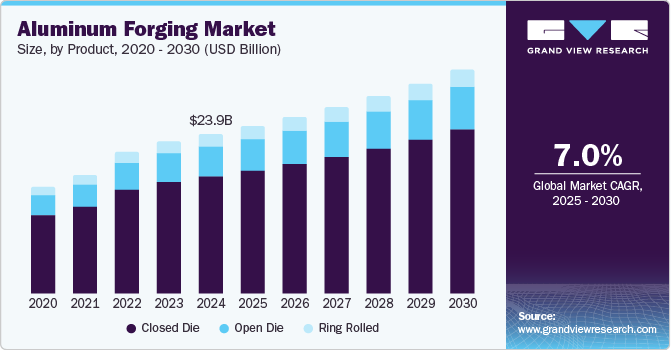
The global aluminum forging market was valued at USD 23.93 billion in 2024 and is anticipated to expand at a CAGR of 7.0% from 2025 to 2030. Growth is largely driven by the increasing use of lightweight materials in the automotive industry. Automakers have long aimed to reduce vehicle weight to enhance fuel efficiency, boost performance, and lower carbon emissions. According to the U.S. Department of Energy, reducing vehicle weight by 10% can result in a 6% to 8% increase in fuel efficiency. As a result, automotive manufacturers globally are increasingly focused on producing lightweight vehicles.
In addition, growing demand for new defense aircraft is expected to propel market growth further. For example, Airbus reported a 200% surge in profits, largely due to rising passenger aircraft sales and increased military aircraft demand. In May 2022, Airbus announced plans to scale up A320 production by 50%, targeting 75 aircraft per month by 2025, reflecting its response to market momentum.
Price Trend Analysis
Since 2023, aluminum forging prices have shown volatility. This trend is fueled by rising demand across electric vehicles (EVs), aerospace, and renewable energy sectors, coupled with high energy costs and supply chain disruptions. The increasing reliance on forged aluminum in lightweight automotive parts and the aerospace industry's recovery have intensified demand.
Product Insights
Aluminum forging involves processing bars, hollows, or simple shapes using flat dies. Components produced are widely used in aerospace, defense, energy, and automotive applications.
Closed-die forging allows for the production of more complex parts with tighter tolerances than open-die forging, due to the use of two or more enclosed dies. It is also more cost-effective for large-scale manufacturing. Components made through this process are especially prevalent in automotive and aerospace industries.
Get a preview of the latest developments in the Global Aluminum Forging Market! Download your FREE sample PDF today and explore key data and trends
Application Insights
Forged aluminum components play a key role in vehicles, particularly in applications requiring high mechanical strength such as chassis suspension systems, steering knuckles, wheels, and air-conditioning scroll plates.
The global automotive industry is accelerating its use of forged aluminum components to achieve vehicle weight reduction. This trend has driven new business for forging suppliers. For instance, in 2022, Bharat Forge secured USD 121.6 million worth of aluminum forging orders from the automotive and industrial sectors. The company reported a 43% growth in its utility vehicle segment in the same year, supported by these orders.
Regional Insights
The Asia Pacific region held over 47% of the global aluminum forging market revenue. This growth is fueled by increased demand from the automotive, aerospace, and industrial sectors. Countries such as China, India, and Japan are boosting the production of lightweight components to comply with stricter emission standards and promote electric vehicle adoption. The recovery of the aerospace industry has further enhanced demand for strong, durable aluminum parts.
However, challenges such as volatile raw material prices and rising energy costs persist. Nevertheless, technological advancements in forging and a growing emphasis on sustainability and recycling are shaping the future trajectory of the market in this region.
Key Players in the Aluminum Forging Market
The following companies are major players in the aluminum forging market, collectively holding significant market share and shaping industry trends:
- Alcoa
- Aluminum Precision Products
- American Handforge
- Arconic
- ATI
- Bons & Evers
- Farinia Group
- FORGINAL industrie
- Norsk Hydro
- STAMPERIE SpA
Gather more insights about the market drivers, restrains and growth of the Aluminum Forging Market


































